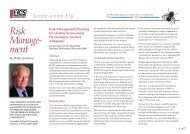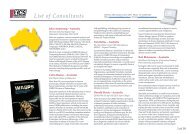Manual for Diagnosis of Screw-worm Fly - xcs consulting
Manual for Diagnosis of Screw-worm Fly - xcs consulting
Manual for Diagnosis of Screw-worm Fly - xcs consulting
Create successful ePaper yourself
Turn your PDF publications into a flip-book with our unique Google optimized e-Paper software.
5. Flies causing myiasis<br />
The following lists those flies most likely to be encountered in cases <strong>of</strong> myiasis plus closely<br />
related or similar looking species, with special reference to SWF myiasis. Distribution maps<br />
<strong>for</strong> most species are given in Fig. 14.<br />
Chrysomya bezziana – Old World screw-<strong>worm</strong> fly<br />
Obligatory myiasis fly (primary screw-<strong>worm</strong>). Serious parasite <strong>of</strong> man and warm-blooded<br />
animals throughout the tropical and sub-tropical Old World.<br />
Cochliomyia hominivorax – New World screw-<strong>worm</strong> fly<br />
Eradicated from southern states <strong>of</strong> U.S.A. and Mexico but still present in Panama and<br />
northern areas <strong>of</strong> South America and most <strong>of</strong> the Caribbean. Accidentally introduced to Libya<br />
in North Africa in 1988. The subject <strong>of</strong> continuing eradication programs in Central America<br />
using sterile flies bred at the Mexican-American Commission <strong>for</strong> the Eradication <strong>of</strong> <strong>Screw</strong><strong>worm</strong>s<br />
facility at Tuxtla Gutiérrez, Mexico. The facility was established in 1976 with a capacity<br />
<strong>of</strong> up to 500 million flies per week.<br />
Chrysomya megacephala – Oriental Latrine fly<br />
Very common species. Adults superficially similar to C. bezziana but generally a larger-sized<br />
species. The larvae breed in carrion or dead, decomposing tissues, very rarely found in<br />
C. bezziana-infested myiasis although adults frequently feed at such wounds. Common<br />
around human habitation. From its origins in New Guinea and the nearby Pacific islands,<br />
C. megacephala is now widespread throughout India and SE Asia with many recent<br />
introductions as far afield as South America, Africa and Japan.<br />
Chrysomya saffranea – Steelblue blowfly<br />
A New Guinea/Australia blowfly species occasionally found breeding in the necrotic tissue<br />
associated with C. bezziana myiasis but normally breeding on carrion. Adults superficially<br />
similar to C. bezziana and very similar to C. megacephala. C. saffranea has been recovered<br />
from cattle myiases in tropical Australia.<br />
Cochliomyia macellaria – Secondary screw-<strong>worm</strong> fly<br />
C. macellaria is the New World equivalent <strong>of</strong> C. saffranea in its bionomics. It is a carrion<br />
breeder but occasionally found associated with Co. hominivorax myiases as a secondary<br />
invader. The adults are superficially similar to Co. hominivorax with which it was<br />
taxonomically confused until 1933.<br />
Chrysomya rufifacies – Hairy Maggot blowfly<br />
One <strong>of</strong> a guild <strong>of</strong> Australian blowflies which occur on sheep. The adults are a metallic green.<br />
The larva, like C. albiceps, has fleshy protuberances (papillae) giving it a hairy appearance.<br />
A secondary blowfly on sheep where its larvae may be predatory on primary blowfly larvae<br />
although large infestations <strong>of</strong> C. rufifacies can cause the death <strong>of</strong> a sheep in a short time.<br />
Occasionally, its larvae are associated with C. bezziana myiases. Accidentally introduced to<br />
southern U.S.A., Central and South America.<br />
Chrysomya varipes – Small Hairy Maggot blowfly<br />
A small species occasionally identified from sheep myiases in Australia.<br />
Agriculture, Fisheries and Forestry - Australia<br />
Chrysomya albiceps – Banded blowfly<br />
Very similar to C. rufifacies adults and with a hairy maggot type but found in Africa, Europe,<br />
Arabia and India. Recently introduced to Central and South America and the Caribbean. It<br />
is one <strong>of</strong> the important blowflies <strong>of</strong> sheep in South Africa but its larval biology seems to be<br />
similar to the secondary C. rufifacies and it is classed as mainly a scavenger species.<br />
17




